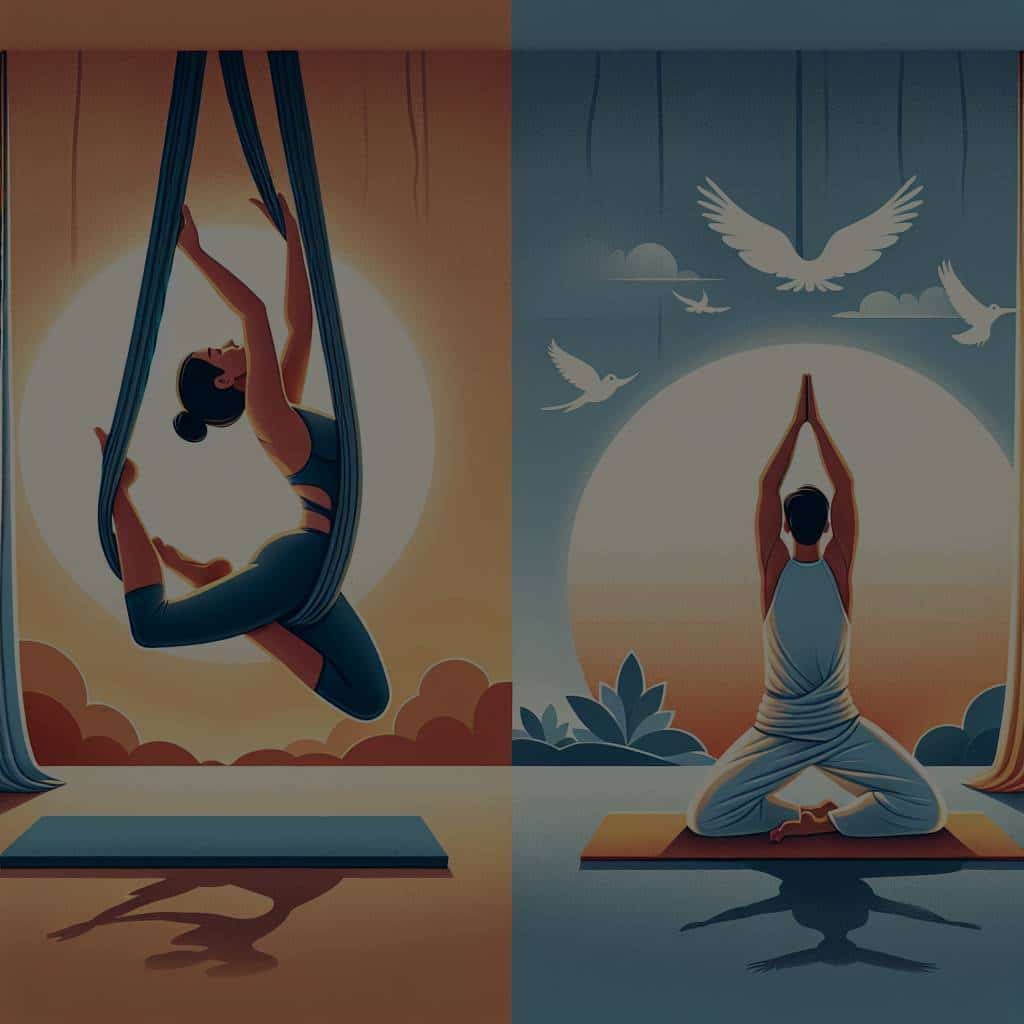In recent years, a new form of yoga has taken flight, captivating fitness enthusiasts across the globe. This novel practice is called aerial yoga, and it merges traditional yoga poses with the use of a hammock. By suspending the body in the air, individuals are able to achieve a unique set of benefits that differ from those of traditional yoga. But the question that arises is, "Does the practice of aerial yoga offer unique health benefits compared to traditional yoga?" In this article, we will delve into the core aspects of aerial yoga, including its benefits, the poses it encompasses, and how it compares to traditional yoga.
Understanding Aerial Yoga
Before we delve into the health benefits of aerial yoga, it’s crucial to understand what this practice involves. Aerial yoga, also known as anti-gravity yoga, uses a hammock or swing made of sturdy, elastic fabric. The hammock serves as a prop that helps you achieve traditional yoga poses, but in an inverted or aerial manner. It’s a fitness regimen that combines elements of yoga, Pilates, dance, and gymnastics.
Also read : How Does Regular Deep Tissue Massage Affect Recovery Time for Athletes?
In an aerial yoga class, the hammock is adjusted to hang at hip level, and you will use it to perform various yoga poses. Some poses involve balancing on the hammock, others engage your core muscles while partially hanging from it, while inversions involve hanging upside down from it. Aerial yoga is praised for its ability to aid in achieving deeper poses and providing a more intense flexibility and strength workout than traditional yoga.
The Unique Health Benefits of Aerial Yoga
Aerial yoga presents an exciting, fun, and challenging way to experience yoga. However, it also offers a plethora of unique health benefits. Your body will reap the rewards of this practice, and your mind will also enjoy a noticeable improvement in its well-being.
In parallel : How Can Genetic Screening for BRCA Mutations Guide Breast Cancer Prevention Strategies?
Increased Flexibility
Aerial yoga helps stretch and lengthen your muscles, promoting overall flexibility. The hammock acts as a prop, allowing individuals to deepen their stretches in a way that might not be possible on a yoga mat. It aids in decompressing the spine, which enhances your range of motion and flexibility.
Enhanced Strength
Strength training is a significant component of aerial yoga. The hammock is not just for balance; it’s a tool that can help intensify your workouts. Many aerial yoga poses require you to hoist your body weight, which builds upper body strength. Core strength is also greatly improved as the instability of the hammock forces your core muscles to work harder to maintain balance.
Improved Balance
Balance is a fundamental aspect of all types of yoga, but aerial yoga takes it a step further. Since many aerial yoga poses involve balancing in the hammock, your core muscles are constantly engaged, enhancing your stability and balance over time.
How Aerial Yoga Compares to Traditional Yoga
Aerial yoga might be a deviation from traditional yoga, but the two practices share many similarities. Both improve flexibility, strength, and balance. However, the use of the hammock in aerial yoga offers an entirely different experience.
In traditional yoga, gravity works against you, making some poses challenging to maintain. In aerial yoga, gravity is your ally. The hammock helps you maintain poses that you might find difficult on the mat. This degree of support allows for deeper stretches and poses, leading to increased physical benefits.
When it comes to inversions, aerial yoga stands out. In traditional yoga, inversions can be intimidating and challenging for many individuals. However, the hammock in aerial yoga makes inversions more accessible and safer, enabling individuals to experience the numerous benefits of inversions without the risk of injury.
In terms of mental benefits, both forms of yoga promote mindfulness and reduce stress. However, many find the playful nature of aerial yoga more enjoyable, which can lead to a higher level of stress reduction.
Getting Started with Aerial Yoga
If you are considering giving aerial yoga a try, there are a few things to keep in mind. First, as with any new fitness regimen, it’s essential to consult with a healthcare provider to ensure it’s suitable for you. Pregnant women, individuals with heart disease, and those with glaucoma or high blood pressure should avoid aerial yoga due to the risks associated with inversions.
Once cleared by a professional, find a reputable aerial yoga studio in your area. A professional instructor can ensure you’re performing poses correctly and safely. Most studios offer beginner classes, which are a great introduction to the practice.
Despite the initial challenge, don’t be discouraged. Like any new skill, it takes regular practice to become proficient in aerial yoga. Continue attending classes and practicing poses at home if possible. In time, you will notice improvements in your flexibility, strength, balance, and overall well-being.
Final Thoughts
Aerial yoga is a dynamic and engaging form of yoga that offers unique health benefits. Although it shares many similarities with traditional yoga, its reliance on a hammock prop provides an entirely different physical and mental experience. Aerial yoga is an excellent way to deepen your yoga practice, improve your strength and flexibility, and bring a sense of playfulness and excitement to your workout routine.
The Mental Benefits of Aerial Yoga
Aside from the physical benefits, aerial yoga can have a profound impact on the mind. Much like traditional yoga, aerial yoga urges a connection between the mind and body, creating a holistic workout experience.
The sensation of floating can often induce a feeling of tranquility and ease. When coupled with the rhythmic breathing exercises commonly practiced in yoga classes, aerial yoga can have a calming influence on the mind. It can help alleviate stress, anxiety, and even depression. Some practitioners have reported experiencing a boost in their mood and overall outlook after a session.
Furthermore, aerial yoga can also foster mindfulness. The concentration required to balance in the yoga hammock keeps your mind focused on the present moment. This act of being present can help alleviate worries about the past or future, thus promoting a state of mental peace.
Aerial Yoga: A Rewarding Journey
Embarking on an aerial yoga journey can be a transformative experience. It challenges you physically, strengthens you mentally, and offers an element of fun and playfulness that is sometimes missing in traditional yoga classes.
Starting a new practice can be daunting, especially when it involves a yoga hammock and gravity-defying poses. But remember, every yogi starts at the beginning. It’s not about perfection, but rather about the journey and the growth that comes with it.
With regular practice, you’ll not only see improvements in your strength, flexibility, and balance but also in your confidence. Aerial yoga can be empowering, leaving you feeling strong, capable, and invigorated after each class.
Conclusion
In conclusion, the practice of aerial yoga indeed offers unique health benefits compared to traditional yoga. The use of the aerial hammock allows for a deeper stretch, promotes greater strength and balance, and makes inversions more accessible. On a mental level, it enhances mindfulness and can contribute to stress reduction.
While it is not a replacement for traditional yoga, aerial yoga is a valuable addition to any yoga practice. It encourages a different perspective, literally and figuratively, and can help break through physical and mental barriers. As with any new fitness regimen, it’s crucial to listen to your body, practice safely, and seek guidance from a professional.
Remember, the goal of yoga is not to touch your toes but to connect with yourself. Whether through traditional yoga or aerial yoga, what matters most is the journey of self-discovery and the positive impacts on your overall well-being.






